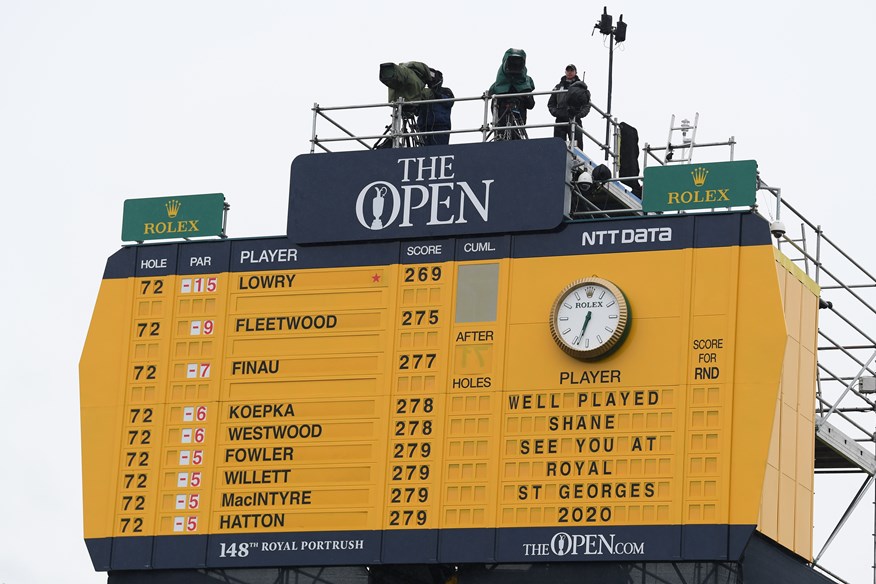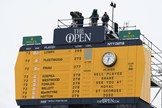Open talking points: Scheduling, Driver Testing and Shouting Fore
Last updated:
Open talking points: Is the major schedule too condensed? Was Xander right to call out R&A over driver testing? And who should take responsibility for shouting fore?
We take a look at three of the biggest talking points from this year’s Open Championship – where Xander Schauffele blasted the R&A, Rose criticised the ‘too condensed’ major schedule and Robert MacIntyre slammed Kyle Stanley for not shouting fore.
Is the men’s major schedule too condensed?
It’s hard to believe that the 2019 major championship season has already come to an end. And while the finale of Shane Lowry’s triumph on home soil was a victory for the Open Championship, you’d be forgiven for thinking it all feels over a little too soon.
The new scheduling saw the PGA shift to May this year, and while the Tour argued it had to do with golf coming back in to the Olympics, there was no doubt that the start of the American Football season also played its part in the move. The result is four majors that are now played in as many months, and there’s no break as the weeks which follow the Open take on a WGC before the final events of the FedEx Cup that finish in August.
It leaves nine months between major tournaments, and reigning champion Justin Rose expressed his concerns that the importance of the majors were being overlooked in favour of the FedEx Cup.
“One major a month really I think is too – in my opinion they’re too soon,” Rose said earlier in the week.
“It’s too condensed. Just the — as a professional in terms of trying to peak for something, the process that’s involved in trying to do that can be detailed and it can be longer than a month. So that’s my reasoning for that.
“But I also think it’s pretty much driven by FedExCup, wanting to finish on a certain date, everything else having to fit in where it can.
“For me a major championship should be the things that are protected the most. That’s how all of our careers ultimately are going to be measured. 30, 40 years ago there wasn’t a FedExCup so if you’re trying to compare one career to another career, Jack versus Tiger, it’s the majors that are — they’re the benchmarks. For them to be tweaked so much I think is quite interesting at this point.”
In the past, the PGA Championship would follow in August while May was reserved for the Players, and yet that major-less month did give the four biggest events of the year a little more breathing space.
But now, with the FedEx Cup’s end shifted to that spot instead, the PGA has moved back to May and we’re sprinting towards the end of another season in the States. Of course, the European Tour’s scheduling means we won’t be without golf at the highest level though, as it finishes three months later in November.
Yet that still leaves golf fans without a major championship for three quarters of the year, and it begs the question of whether making it more condensed, rather than spread out, has been a smart move for the game. Plenty of players ended up taking the full three weeks between U.S Open and the Open off because of scheduling conflicts, and both Justin Thomas and Tiger Woods admitted that trying to figure out which tournaments to play at this year had been an adjustment.
Rose’s argument is that this unrelenting four-month major span doesn’t give players enough of a gap to get their game’s to peak for the majors, but could they be more spaced out? Part of the issue is that unlike tennis, where the four tournaments are spaced between January and September in different parts of the World, three of golf’s biggest events take place in the United States.
Another move also feels unlikely so soon, but if there were a major to be changed, it would most definitely be the PGA Championship once more: The Masters has solidified it’s position in April, the U.S Open in June and Open in July, although another week of separation wouldn’t do them any harm. They also each have distinct indentities, something the PGA Championship has always struggled to achieve.
As Rose argues, the success of a career has always been measured in major championships, and by keeping them as they are, there’s an argument that the Tour is placing more importance on the FedEx Cup – a finale that rewards a bonus to the winner which is more than five times bigger than the amount Shane Lowry won at Royal Portrush.
When the dust settles on the week of Ireland’s shining glory, are golf fans going to feel hard done by because of it? Sure, the FedEx Cup is important, but the majors are still the pinnacle of the sport, and nine months between them seems far too much.
The counter argument is that it’s really only one month less than it was before, and next year the run will be more condensed when you add in the Olympics and the Ryder Cup, but eight months was already a huge gap.
In our opinion, the majors should be protected at all cost, and we’re not quite sure if four consecutive month’s of golf’s biggest events are the right way to do that.
Was Schauffele right to call out R&A over random driver testing?
Xander Schauffele grabbed plenty of headlines earlier in the week when he spoke about being ‘pissed off’ after having a ‘run in’ with the governing body over the issue on non-conforming clubs.
He was selected as one of 30 players to have their driver tested for the CT limit at the start of the week, but it soon became common knowledge that his Callaway club had failed the test. Schauffele had no qualms about handing it over, but he did question the fairness of it all, and blasted the R&A for how they dealt with it. In his eyes, it should have been a private matter, but everyone seemed to know.
Schauffele’s biggest issue was surrounding the selection of 30 random players, arguing that every player in the field should be tested – as while they took his, there could still have been any number of players with a non-conforming driver still competing.
“I had a little bit of run-in with them, because they only test 30 players,” he said. “I thought it was a little bit unfair — I would gladly give up my driver if it’s not conforming.
“There’s still 130 other players in the field that potentially have a nonconforming driver, as well. What’s the fair thing to do? Just test the whole field. It’s plain and simple.”
It left the World No.11 having to use a new club, something he expressed wasn’t part of his plan for Open week, and it was something he couldn’t get over, going on to say he wasn’t the only player with a club that didn’t meet the requirements.
In all honesty, Xander has a point. Who is to say other players didn’t have conforming clubs? In the interest of the upkeep of integrity in the game, we’d definitely support an entire field driver testing rather than sticking to 30 random players.
But Schauffele’s argument shouldn’t just be with the R&A. He’s a contracted player, and he and the brand he plays for surely should check that his driver is conforming before he comes to a major championship and has to change his equipment.
Who’s responsibility is it to shout ‘fore’?
It’s the question that rears its head on a nearly weekly basis, and it’s a subject that became a big point of discussion at Portrush when 22-year-old rising star Robert MacIntyre was involved in a heated exchange with playing partner Kyle Stanley.
MacIntyre and Stanley were grouped together during the second round when Stanley struck a marshall on the 12th and the mum of MacIntyre’s caddie on 14. The young Scot was unhappy that Stanley hadn’t shouted ‘fore’ and told him as much, while Stanley felt that it was a non-issue because several people had – even if it wasn’t him. Both players had their say to the media, but it brought about a discussion on the topic that shouldn’t be quickly dismissed.
“After I hit several people on the tee box yelled “fore.”,” Stanley had argued. |My two playing partners, my caddie, a couple of the volunteers or the marshals, even had them signalling it was going right. I mean, everyone to the right of that ball, they knew it was coming. So to me it’s kind of a nonissue.
“He made the argument that since I hit the ball that it maybe should have come out of my mouth first. I guess I can see that. But it’s unfortunate it ended up the way it did. It certainly wasn’t my intention to put anyone in harm’s way.”
Just six weeks ago the PGA Tour sent out a memo reminding players that they should be shouting, but they haven’t yet taken a hard stance on the matter like European Tour – who now fine players if their golf ball causes imminent danger and they fail to shout.
Stanley belongs to the train of thought that thinks signalling, and anyone in the group shouting, is more than enough to help indicate to marshall’s, but Ernie Els was quick to back up the Scotsman’s view that responsibility should belong with the player.
“When you hit a wayward shot and you don’t shout ‘Fore’, I don’t get that,” said Els after his third round at Royal Portrush. “I don’t know why people would do that. I’ve hit a lot of foul balls and I’m shouting ‘Fore’ as it leaves the club. Even if my playing partner hits it wayward, I’m going to shout even if he doesn’t because I’ve got my wife and daughters in the crowd.
“I’m not a rules man, but if there’s video evidence, they should take action. We as players, and the governing body, should do something about it.”
Graeme McDowell said that on the PGA Tour it’s easy to get lazy because of the quality of the marshall’s who warn the crowds, but conceeded it’s the professional responsibility of the players to try harder.
“Sometimes you look at watching a ball and you kind of forget sometimes, especially on blind tee shots, that there are some crowds around the corner,” said McDowell. “We do get lazy sometimes because the marshaling is so good. There’s a lot of signaling. There’s a lot of forecaddying going on from the tee box. The quality of marshaling and the quality of setup sometimes makes us a little lazy as players because the guys on the tee are giving great signals.
“I do feel like it’s a professional responsibility to try and warn a crowd if your ball is heading that direction. Do I always shout “fore” when my ball goes in the crowd? No. Sometimes I make a mistake and don’t realise that my ball is going to be as close to the crowd as it is. But the ball is obviously heading in that direction. I try my best to shout all the time.
“It would be hard to live with myself if I hadn’t shouted and I hurt somebody really badly. That would keep me awake at night.
“Like I say, professional responsibility, try and do your best. It’s not always easy to get it right all the time. But I think guys need to shout a little harder. And like I say, we do get lazy for obvious reasons.”
It’s clear that Stanley is overruled on this one, and while he was right that there were plenty of people helping him to make a warning, ultimately he should have taken the responsiblity on himself rather than relying on others.
For MacIntyre it all comes down to etiquette, and something golfers are taught from a young age when there isn’t a big group or marshall’s to help warn others on the course: If in doubt, shout.
“It’s the etiquette of the game,” he said. “It’s my opinion. I’ve said my piece. I done what I felt I had to do. There’s nothing else I can do.”



